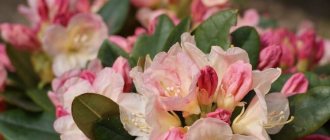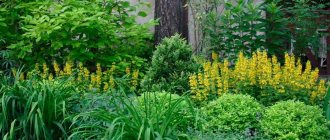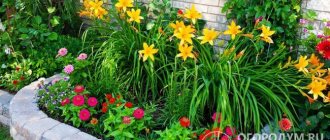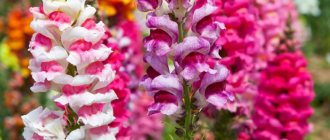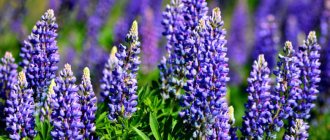Although ornamental plants, like any other plants, require standard care in the form of watering, fertilizing and weed control, there are still some growing peculiarities. Proper planting and care of ornamental shrubs is the key to successfully growing these unusual crops in your garden.
From this article you will learn useful information about the features of planting and caring for ornamental shrubs, and examples of growing some popular species will help you establish proper care for crops in the garden.
- Ornamental shrub barberry, planting and care: video
Types of ornamental shrubs with photos and names
It is difficult to imagine a garden plot without perennials. Among them, a special place is occupied by ornamental shrubs, which not only decorate the garden, but also serve to divide it into zones and decorate borders; they are part of the hedge and act as an excellent background for flowers.
All decorative similar crops are usually divided into the following types (Figure 1):
- Blooming
- Decorative foliage
- Tall
- Ground cover
Among the listed species, flowering plants are the most popular, but you should remember that other beautifully flowering perennials are very demanding to care for, and therefore, when choosing a design for your dacha, think about whether you can pay enough attention to all the crops.
Note: Experienced gardeners know that the less care a plant requires, the longer it retains its blooming appearance. There are not very many such unpretentious and at the same time beautiful species, so you can easily familiarize yourself with the types of ornamental shrubs by photos and names.
The leaders in beauty and unpretentiousness are such flowering species as lilac, garden jasmine (mock orange), spirea, fieldfare, bladderwort, Japanese quince, blue honeysuckle, three-lobed almond, hydrangea.
Figure 1. Types of ornamental shrubs for cottages and gardens
Since the above plants bloom only in summer, it would be useful to diversify the garden flora with leafy and fruit crops. A unique highlight of your garden plot will be European euonymus, snowberry, golden currant, viburnum, rose hips, serviceberry, and hawthorn. Among the ground cover plants, pay attention to sedum, phlox, corydalis, related knotweed, grass carnation, etc.
Bladderwort
And this name of a flowering shrub for a summer residence is not often heard by novice gardeners. The culture is not particularly popular, but this does not mean that it does not have stunning decorative characteristics. The bush looks especially beautiful in autumn: white flowers, golden leaves.
A distinctive feature of this crop is its long flowering period, which begins in the first half of summer. Flowers remain on the bushes until mid-October or even early November. Some varieties produce red-purple fruits that are inedible.
In most cases, the crop is grown as a separate bush, although in skillful hands it can also be used to create unusual compositions. For example, bladderwort goes well with red rowan (we are talking not only about decorative qualities, but also excellent “neighborhood” indicators).
It is best to plant the plant in open areas where the sun always shines. In shaded areas, flowering will not be as abundant, and the leaf blades may simply not change their color with the arrival of the autumn season. You should also take care to protect the area from the wind.
As for caring for an adult plant, the bladderwort does not have any special preferences. It will be enough to moisten the substrate in a timely manner, as well as regularly spray with mineral fertilizers so that the buds and flowers grow stronger.
Landing options
You should know that the semantic completeness of the composition depends on the correct design of the planting of shrubs, if these plants are planted to mark the boundaries of your garden design ideas (Figure 2). But it happens the other way around, when an ornamental shrub is the center of the composition, and it is surrounded by other plants, for example, flowers. A properly laid foundation of the garden, in the form of trees and bushes, guarantees its longevity, because on an already formed background you can successfully create various compositions, changing or adding details in the form of plant or architectural elements. To do this, you must initially choose the right plants for the base, that is, compare not only their appearance, but also their physical characteristics (height, crown shape, leaf color). And, of course, the correct placement of plants in the garden.
Note: Garden landscape designers advise placing such crops in those places on the site where they can emphasize the shape of the topography and structures, the configuration of paths and other objects. Thus, ornamental shrubs look impressive near garden stairs and retaining walls, as well as at forks and turns of paths.
The location of the plant on the lawn, flower garden, or next to it will be unusual. Original ideas also include planting in so-called modules, that is, placing plants in specially designated places. Another beautiful design idea is to arrange plants using bouquet planting.
Figure 2. Options for placing ornamental shrubs in the garden
Quite often, shrubs are supplemented with annual and perennial flowers, cereals, and various decorative elements. In addition, they are wonderful decorators, because if positioned correctly, they can hide the problems of the garden, and also help to visually enlarge the boundaries of the garden area. They are successfully used to create hedges. Qualified garden design specialists know the rule well: no matter what style your garden is designed in, the surrounding nature should be reflected in it, as in a mirror.
Distance between plants:
To plant ornamental shrubs, calculate the distance between plants. I add up the height of neighboring bushes and divide by the number three. The resulting number will be the distance between neighboring bushes. Example - White dogwood up to 3 meters high. This means that if we plant two bushes side by side (3+3): 3 = 2m. This means that 2m between them will be enough. But the width of the crown of Derain white reaches 3 meters. Here you have to look - or plant it 3 meters wide, and the crowns will be free-standing. But the minimum distance in the composition is 2 meters. In a hedge, the distance is reduced to 1 m or even closer to 0.5 -0.3 meters.
Planting ornamental shrubs in spring
Since ornamental shrubs are perennial plants and grow in one place for a long time, it is necessary to carefully approach the procedure for planting them in the ground (Figure 3).
As a rule, they are unpretentious to the place where they grow, although among them there are those that prefer only a certain type of soil and its level of moisture. In addition, you should know that when planting in spring, all work must be completed before active growth begins, that is, before the buds open. Let's take a closer look at the features of growing and caring for shrubs in the spring.
Landing Features
First of all, you need to start preparing the soil. It must be dug to a depth of two spade bayonets, while simultaneously removing weed roots and large stones. Next, the sandy soil should be enriched with humus, clay or turf soil, and the clay soil should be diluted with a mixture of sand and humus. For plants that love acidic soil, add peat, and a week before planting, add mineral fertilizer.
It is important to know that seedlings with bare roots must be planted in the soil immediately, but plants in containers or with a bagged clump can wait a few days.
Note: If circumstances are such that you do not have time to plant the plant, wrap its roots with wet burlap and polyethylene. Store the seedlings in a cool place until planting, or bury their roots and part of the trunk, then water and compact the soil.
When planting a plant in a hole, make sure that its roots are straightened and the root collar remains at soil level after planting. Don't forget to compact and water the soil. To prevent water from spreading, it is recommended to make a low earthen roller around the trunk of the plant. Seedlings in standard form must be tied to support pegs. Do not forget that the seedlings have not yet reached the size of an adult plant, so when planting, make room for growth.
Figure 3. Features of planting ornamental crops
The recommended distance between plantings is from 120 to 200 cm, and for some plants with a large crown - more than 2 meters. Do not be confused by the resulting voids between the seedlings, because they can easily be filled with bulbous and rhizomatous plants. Over time, the bushes will grow and the voids will disappear. If, nevertheless, you have planted bushes densely, then heavy pruning will help to restrain their growth, the disadvantage of which is the loss of decorativeness.
Preparatory work:
Usually the issue of growing and planting shrubs is decided in advance one season before planting. This year they are doing preparatory work - choosing a planting site, composition, and accompanying plants. Prepare the site - destroy perennial weeds, level the site, and make drainage ditches if necessary. The next year, shrubs are planted.
How to beautifully grow ornamental shrubs.
Ornamental almond shrub: planting and care
When deciding which ornamental shrubs to plant in your dacha, we recommend paying attention to almonds. It is well known not only for its delicious aroma but also for its beneficial fruits. This plant is heat-loving and afraid of drafts (Figure 4).
Note: The easiest way to grow almonds is from a seedling; it is recommended to plant two or three plants together for better pollination.
Planting and caring for almonds includes a standard set of activities. For planting, it is necessary to prepare planting holes, the size of which should correspond to the earthen ball. It is recommended to cover their bottom with a layer of sand and crushed stone, and add lime to the soil. To give the seedling additional support, install a stake at the bottom of the hole to which you can tie the plant after planting.
Figure 4. Growing almonds in the garden
Further care consists of weed control, loosening the soil, fertilizing, pruning, as well as protection from diseases and pests. Watering should be moderate and carried out as the earthen ball dries out, because a lack of moisture leads to a shortening of the flowering period and affects the harvest. Spring fertilizing involves applying rotted manure to the plant, and autumn fertilizing is carried out using superphosphate and potassium sulphide. In early spring, sanitary pruning is carried out, removing all dry and diseased shoots. Upon completion of flowering, it is also necessary to carry out formative pruning, removing annual shoots.
Pros and cons of a green fence
A significant advantage of living fencing is the huge range of materials available. Numerous varieties, breeds, subspecies that can provide the owner with all the necessary qualities and get along with each other when forming a combined fence. Lush foliage, rich crown color, beautiful flowering, and a pleasant smell are the companions of a natural protective structure.
Vegetation will give the site a neat, aesthetic appearance and protect the area from uninvited guests and prying eyes. The bushes are absolutely environmentally friendly, the material will not emit any harmful substances, there will be no need to use a welding machine, metal fasteners, or plastic sheathing.
The disadvantages include the need for periodic mowing, soil fertilization, regular watering, and loosening the soil. Fertilizers for laying in the soil should be selected in relation to the type of shrub.
If the variety of vegetation chosen by the owner is subject to disease or pest attacks, all external characteristics may be lost. The required protective treatment may not always be carried out due to the density of the crown and the use of chemicals that will be absorbed into the ground and greenery growing on the site.
Ornamental shrub St. John's wort: planting and care
Only a few species of this medicinal plant are used for decorative purposes: St. John's wort, St. John's wort and St. John's wort (Figure 5). This plant is unpretentious, and therefore does not make any special demands on the planting process. As a rule, it is carried out in the autumn, before the onset of frost. A spacious, open, sunny area is best suited for growing St. John's wort.
Note: Due to the fact that St. John's wort grows significantly in width, it is necessary to provide sufficient distance between individual specimens. Since the root system of the plant is not very branched, the planting hole will need to be shallow. It is advisable to sprinkle a little humus and a mixture of leaf soil with mineral fertilizers on its bottom to provide nutrition to the plant for many years.
There is no need to fertilize immediately after autumn planting. It will be much more appropriate in the spring, before the buds open. At this time, liquid fertilizer in the form of a diluted infusion of mullein or bird droppings will be useful. Nitrogen fertilizers promote the formation of foliage and flower ovaries. The total number of feedings per season should be 2-3 times.
Figure 5. St. John's wort in the garden
Remember that fertilization occurs only in moist soil, and although St. John's wort is an unpretentious plant, it needs additional watering in dry times. At the same time, watering should not be too abundant, because excess moisture is detrimental to the roots. Since St. John's wort is a semi-evergreen plant, it requires seasonal pruning, which is carried out in the spring. In this case, some of the old foliage is removed to make room for new leaves. Ornamental St. John's wort does not need shelter for the winter.
The author of the video will tell you more information about flowering shrubs.
We determine the characteristics of the site.
Winter hardiness zone: Determine which plant winter hardiness zone your area of residence belongs to.
Soil: what kind of soil is in the area that you have chosen to grow your shrub - clay, loam, sandy, arable fertile land. Determine what acidity the soil is - acidic, slightly acidic, alkaline or neutral.
Water: how your site is located. Flooding in spring when snow melts. Flooding after heavy rains.
Illumination of an area: how long this area is in the sun or shade during the day.
Wind: How much wind blows the area.
Ornamental shrub barberry: planting and care
Decorative barberry is another representative of unpretentious and durable crops, which, moreover, has frost and drought resistance (Figure 6). As the plant matures, it grows so much that it becomes an insurmountable barrier, and therefore is often used as part of hedges. Barberry lends itself well to pruning and, with proper care, is a decoration of the garden all year round.
Note: His only weakness is his fear of nearby groundwater and flooding. It is for this reason that it is not recommended to plant barberry in lowlands. Also, when planting, you should take into account that in shaded places it loses its decorative effect and almost does not bear fruit.
The dimensions of the planting hole are 40x40x40 cm, while on heavy soil these parameters increase. Superphosphate (200 g), potassium sulfate (100 g) and microelements for berry crops are added to the planting soil. After the soil settles in the hole, you can proceed directly to planting. Remember that the seedling should be buried so that the root collar is not covered with soil. The planted seedling should be watered abundantly and the soil around it should be mulched.
Figure 6. Growing barberry in the garden
Barberry can be planted both in early spring, before buds open, and in autumn, in September. For container plants, planting time does not matter. You just need to avoid planting on hot days and shade the seedling in the first days. In the first year after planting, the shrub does not require special care. Only in the second year should barberry be fertilized with nitrogen and potassium in early spring, as well as superphosphate in late summer. A mandatory procedure for caring for this species is formative pruning, since barberry grows very quickly. Therefore, it is necessary to regularly remove the central skeletal branches that thicken the crown. An adult plant is not afraid of cold weather, but young specimens may suffer from frost. Therefore, in the first two years it is recommended to cover them with burlap for the winter.




